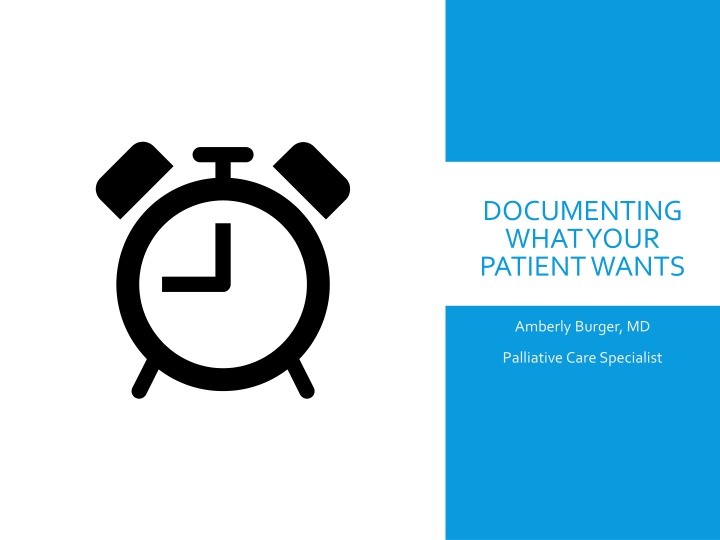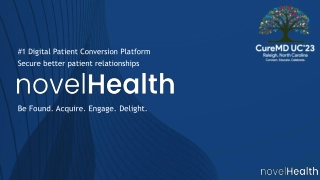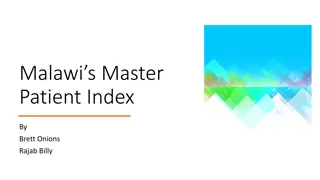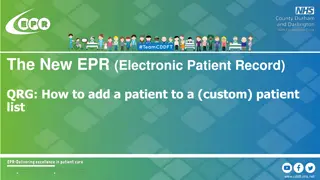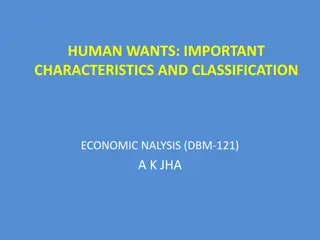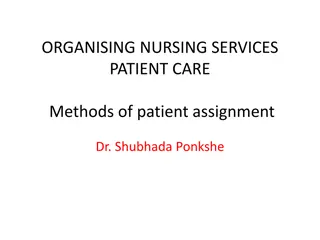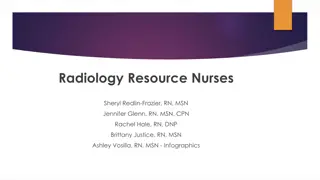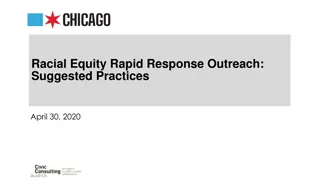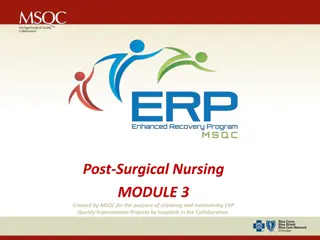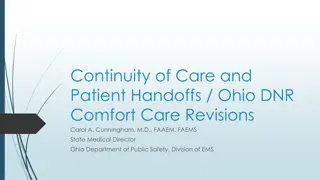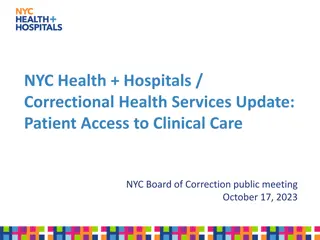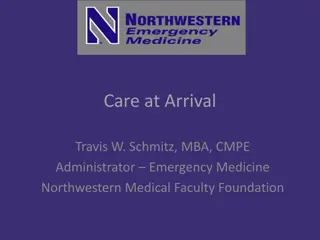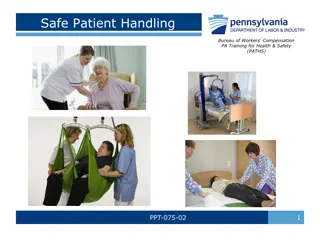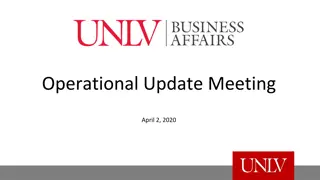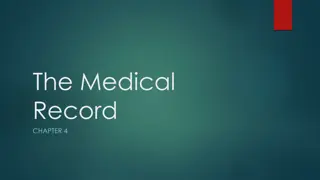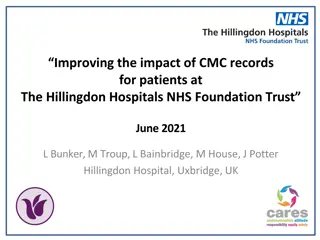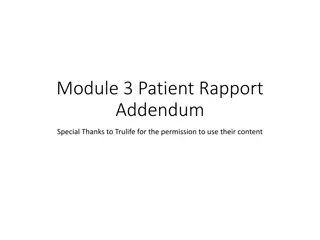DOCUMENTING WHAT YOUR PATIENT WANTS
This document discusses important aspects of documenting a patient's wishes in palliative care, focusing on advanced directives, decision-making hierarchy, CPR outcomes, and specific case scenarios. It also covers healthcare proxy, DNR orders, and the role of physicians and designees in treatment decisions. Understanding these key elements is essential for providing patient-centered care.
Download Presentation

Please find below an Image/Link to download the presentation.
The content on the website is provided AS IS for your information and personal use only. It may not be sold, licensed, or shared on other websites without obtaining consent from the author.If you encounter any issues during the download, it is possible that the publisher has removed the file from their server.
You are allowed to download the files provided on this website for personal or commercial use, subject to the condition that they are used lawfully. All files are the property of their respective owners.
The content on the website is provided AS IS for your information and personal use only. It may not be sold, licensed, or shared on other websites without obtaining consent from the author.
E N D
Presentation Transcript
DOCUMENTING WHAT YOUR PATIENT WANTS Amberly Burger, MD Palliative Care Specialist
TABLE OF CONTENTS Understand Advanced Directive Uses Know hierarchy for decision making Review CPR Outcomes
Large Subdural Hematoma 60s, CKD III Fell Only 1stDegree relative stuck and very difficult Patient unconscious No HC-POA JOAN S STORY
Per Indiana Code 16-36-5 and 16-36-6 Cardiac compression Endotracheal intubation Artificial ventilation CPR DEFINITION Defibrillation Administration of cardiac resuscitation medications, Related procedure NOTE: not Heimlich maneuver
POST: Physician order for Scope of Treatment Out of Hospital DNR ADVANCE DIRECTIVES Healthcare Power of Attorney Healthcare representative Living Will Life Prolonging Procedures Declaration
Only active when a patient cannot make decisions Heath Care Representative, or POA Physicians, Advanced practice nurse, physician assistant (designee may discuss and complete the form) POST ENGLISH SPEAKING ONLY Attorney in fact Patient or designated person 18 yrs or older Guardian Court appointed health care representative Follows the patient unless revoked by patient or designated person Signed and dated writing, destruction, spoken statement of revoke
DNR orders only by attending physician;16-36-5- 12 No recovery INDIANA CODE DNR FORM Only for a patient with a terminal condition Death within a short time OUT of hospital DNR has no effect when patient is pregnant; 16-36-5-14 OR medical condition in which CPR would be unsuccessful
Means no intubation, no CPR Only helpful when present: must be visible DNR FORM: STATE OF IN Does NOT follow patient to new location Michigan s form very different
Depends on form used and who signs notary or lawyer versus witnesses HEATHCARE REPRESENTATIVE VS. POA Function is to make medical decisions when patient does not have ability to make these: coma, delirium, after trauma Does not have anything to do with finances
SURROGATE DECISIONMAKER HIERARCHY FOR AN ADULT Guardian Spouse Adult children majority rules Parent Sibling (step counts) Grandparent Adult Grandchild Other relative Friend/religious superior NOT: Spouse who is legally separated Protective order to avoid the patient Pending criminal charges as the patient is the alleged victim
Filled out by patient Does NOT talk about mechanical ventilation as most believe LIVING WILL: STATE OF IN Talks of artificial nutrition and hydration in terminal states Holds NO LEGAL VALUE, merely a talking point; physician cannot be prosecuted for following this Studies show that spoken or written living wills of the same help to decision makers EMS cannot use this when caring for a patient
FINANCIAL POA Form completed with notary or lawyer s review Person has access to patient s finances at time document in signed until patient s death May be included in same sets of documents at HCPOA
Changing health states LIMITS OF ADVANCE DIRECTIVES Changing family responsibilities Unknown future events Paperwork not easily found
Polio epidemic: mouth to mouth ventilation (volunteers were paralyzed) Mouth to Mouth on a suffocated coal-pit miner Massaging the heart during surgery BLS CPR: EVOLUTION 1732 1740 1874 1891 1946 1947 1960 Paris officially recommends Mouth to mouth for drowning victims external compressions internal cardiac massage and defibrillation
97 episodes of TV CPR watched 75% of persons survived the immediate arrest 67% survived to hospital discharge.1 MISCONCEPTIONS AMONGST THE PUBLIC 70 years and older interview ed 81% believed that their chance of surviving inpatient CPR 50% believed they would leave the hospital 23% believed that their chance was 90% or better.2
Early CPR and defibrillation within the first 35 minutes after collapse,plus early advanced care can result in high (greater than 50 percent) long-term survival rates for witnessed ventricular fibrillation 25% alive at discharge Multi-center study of patients with Pulmonary Hypertension: 132 pts underwent CPR, 6% patients survived 90 days with NO residual neurologic deficit RESUSCITATE LIMITATIONS AHA stated adult cardiac arrest is 18% hospital survival rate; pediatric 36%8; Hospital GWTG 22.3% survival, of those 28.1% with significant neurologic disabilitiy7 Operating/postanethesia units 37% survival7 10-13% survival of out of hospital9
ON WITHDRAWAL OF SUPPORT "Everyone, regardless of physical condition, is entitled,if competent, to refuse lifesaving medical treatment; no one is permitted to assist a suicide," the Court wrote. "When a patient refuses life-sustaining medical treatment, he dies from an underlyingfatal disease or pathology; but if a patient ingests lethal medicationprescribed by a physician, he is killed by that medication. 5
WITHDRAWAL OF LIFE SUPPORT Euthanasia not condoned or authorized by Indiana law. This chapter does not authorize euthanasia or any affirmative or deliberate act or omission to end life other than to permit the natural process of dying, including the withholding or withdrawing of life prolonging procedures under this chapter Indiana Code
RELIGIOUS STATEMENTS Pope John II s allocution of Artificial Nutrition and Hydration to all in Persistent Vegetative State (towards the end of his life he denied further tube feedings) Cardinal Rigali extended this to include chronic debilitating states and dementia Islam does not allow for withdrawal of artificial nutrition unless it is causing harm to the body
REFERENCES 1. Adams, DH; Snedden,DP; How Misconceptions Among Elderly Patients Regarding Survival Outcomes of Inpatient Cardiopulmonary Resuscitation Affect Do-Not-Resuscitate Orders . JAOA . 2006; 106: 402-404 2. Cooper, JA, Cooper, JD, Cooper JM.Cardiopulmonary Resuscitation: History, current practice and future direction. Circulation. 2006; 114: 2839-2849. 3. http://www.americanheart.org/presenter.jhtml?identifier=4483 4. HOEPER , M. et al. Outcome after Cardiopulmonary Resuscitation in Patients with Pulmonary Arterial Hypertension . Am. J. Respir. Crit. Care Med. 2002; 165: 341-344 5. LUCE, JM and ALPERS, A Legal Aspects of Withholding and Withdrawing Life Support from Critically Ill Patients in the United States and Providing Palliative Care to Them. Am. J. Respir. Crit. Care Med. 2000; 162: 2029-203 6. http://www.commonwealmagazine.org/vatican-artificial-nutrition-and-hydration 7. Meaney, PA el. Al. Cardiopulmonary Resuscitation Quality: Improving cardiac resuscitation outcomes both inside and outside the hospital. Circ. 2013;128:417-435. 8. Girotra, S. Et al. Trends in survival after in-hospital cardiac arrest. N Engl J Med 2012; 367:1912-1920 9. Aufderheide, TP et al. Implementing the 2005 American Heart Association Guiddelines improve outcomes after out-of-hospital cardiac arrest. Heart Rhythm. 2010; 10:1357-1362.
